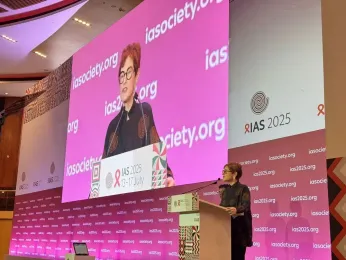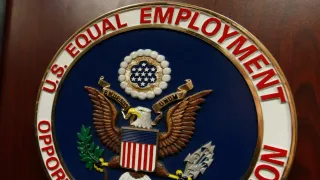
Jul 16
HIV conference in Africa focuses on funding cuts
Liz Highleyman READ TIME: 5 MIN.
The 13th International AIDS Society Conference on HIV Science kicked off Sunday, July 13, in Rwanda, a country hard hit by AIDS that has managed to largely bring its epidemic under control. The country offers a model for combatting the epidemic in sub-Saharan Africa.
While the confab included the usual gamut of HIV prevention, treatment, and cure research, the focus this year was the effects of the Trump administration’s sudden deep cuts to foreign aid, including funding for HIV services.
Meanwhile, in a bit of good news, on Tuesday night the U.S. Senate advanced President Donald Trump’s rescission request to slash $9 billion in federal funding with a tie-breaking vote by Vice President JD Vance, after agreeing to spare $400 million for the President’s Emergency Plan for AIDS Relief, or PEPFAR. The program has long enjoyed bipartisan support, and members of both parties opposed Trump’s proposed cuts to it.
IAS officials noted that the PEPFAR funding is not a done deal.
“However, both the Senate and House must still vote on the final rescission package, and further changes could be reintroduced before the statutory deadline for action,” the agency stated July 16.
In Rwanda, conference organizers noted the changed political reality. The conference was presented both in person and virtually; the Bay Area Reporter watched the proceedings online.
“This year’s conference takes place at a paradoxical moment for all of us who have dedicated our careers to ending the HIV pandemic,” said IAS President Dr. Beatriz Grinsztejn. “On the one hand, we’re witnessing extraordinary scientific breakthroughs that could transform prevention and treatment and even bring us closer to a cure. On the other hand, these very advances are under threat from massive funding cuts that risk stalling clinical trials, slowing our progress, and jeopardizing the progress we’ve fought so hard to achieve.”
On July 10, UNAIDS released its annual global AIDS update, which also focused on the funding cuts. According to the report, there were 1.3 million new HIV infections in 2024 and more than 9 million people living with HIV were not on life-saving treatment – numbers that are only expected to worsen.
“This is not just a funding gap – it’s a ticking time bomb,” said UNAIDS Executive Director Winnie Byanyima. “We have seen services vanish overnight. Health workers have been sent home. And people – especially children and key populations – are being pushed out of care.”
The conference comes a month after the U.S. Food and Drug Administration approved twice-yearly lenacapavir PrEP. On July 14, the World Health Organization released new guidelines recommending lenacapavir as an additional HIV prevention option. Global health officials and advocates have been optimistic that the biannual shots could turn the tide on the epidemic, but the funding cuts raise concerns that the new prevention tool will not reach all those who could benefit.
“We cannot repeat the mistakes of the past, where new medicines existed but stayed out of reach for the people who needed them most,” said Yvette Raphael, executive director of Advocates for the Prevention of HIV and AIDS. “We need clear plans and real funding to make sure these drugs are affordable, available in our clinics, and trusted by our communities. Science has given us powerful tools. Now we must do the work to put them in people’s hands.”
Cuts have profound impact
One of Trump’s first moves after his January inauguration was to slash funding for USAID, which oversees PEPFAR. Launched by President George W. Bush in 2003, PEPFAR is credited with saving 26 million lives and has been the largest funder of PrEP worldwide.
Although Secretary of State Marco Rubio indicated that funding for HIV treatment would continue, prevention funding was limited to pregnant and breastfeeding women, and health officials and providers in low-income countries say their ability to provide care and services has been severely curtailed.
Several presentations at the conference detailed the current and projected effects of the funding cuts. For example, a study from Mozambique – which has the third highest number of people living with HIV – saw a 25% reduction in the number of adults starting antiretroviral treatment in February 2025 compared with the same month last year. Among adults on treatment, there was a 38% reduction in viral load tests and a 33% reduction in viral suppression, with even larger declines among children.
Looking forward, a modelling study by Jack Stone, Ph.D., of the University of Bristol, and colleagues found that the halt to PEPFAR PrEP funding could lead to more than 6,600 additional HIV cases over a year in sub-Saharan Africa, including 2,900 cases among gay and bisexual men and more than 2,000 among women sex workers.
“The sudden cuts to U.S. funding have been deeply felt across the African continent by the millions of people who rely on HIV prevention, testing and treatment services, and by the researchers and health workers striving to end the pandemic,” IAS President-elect Kenneth Ngure, Ph.D., said in a statement.
Beyond the funding cuts, speakers also decried the growing anti-science climate under the new U.S. administration.
“It was science that gave us highly active antiretroviral therapy, PrEP, PEP [post-exposure prophylaxis], and U=U [undetectable equals untransmittable],” Grinsztejn said at the conference’s opening session on Monday, referring to the fact that people on effective treatment do not transmit HIV via sex. “It is science that must continue to drive innovation, from long-acting injectables to vaccines and a potential cure. To do this, the independence and integrity of health institutions and universities, of researchers and medical experts, must continue to drive us towards evidence-based solutions.”
Numerous speakers discussed prospects for alternative funding, including more domestic spending and contributions from philanthropic groups such as the Gates Foundation, but noted that it will be difficult to replace the lost U.S. money quickly. What’s more, many low- and middle-income countries are burdened by international debt that hampers their ability to increase their HIV funding.
“You can’t end the AIDS pandemic while African nations must choose between paying creditors and saving lives,” Zackie Achmat, founder of the Treatment Action Campaign in South Africa and a member of the Global HIV Treatment Coalition, said during a pre-conference media briefing.
Ahead of the meeting, advocates issued the Kigali Call to Action, a global appeal urging governments, development partners, and the global community to protect and sustain the progress made in the fight against HIV. Notable signers include WHO Director-General Tedros Adhanom Ghebreyesus, Ph.D., singer Annie Lennox, former National Institutes of Allergy and Infectious Diseases director Dr. Anthony Fauci, and Oakland Mayor Barbara Lee, a longtime HIV champion.




